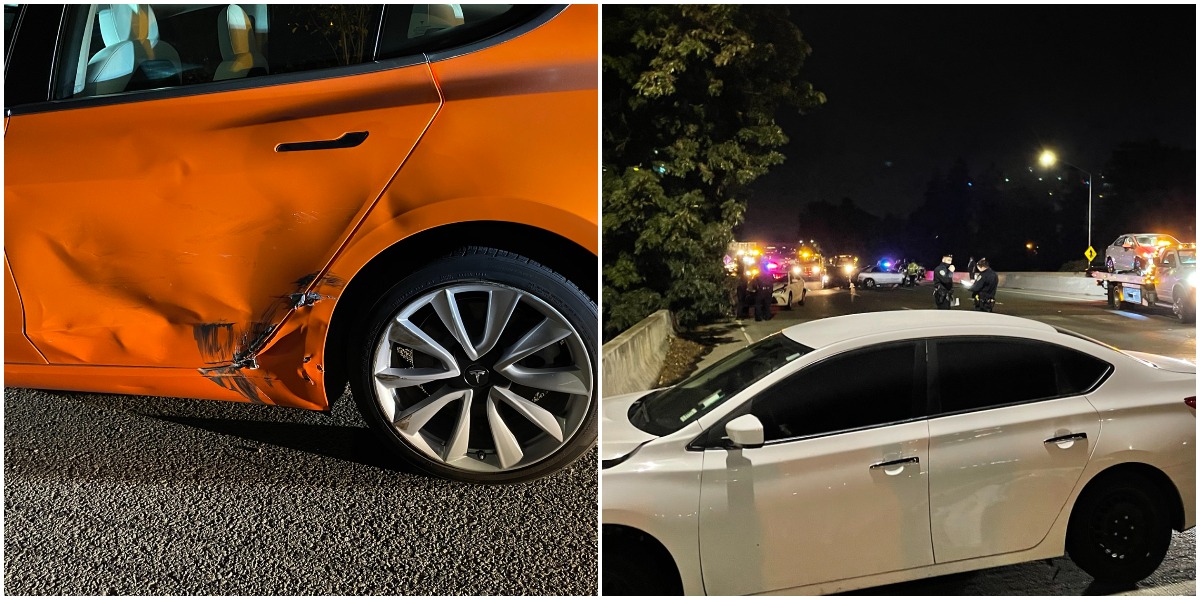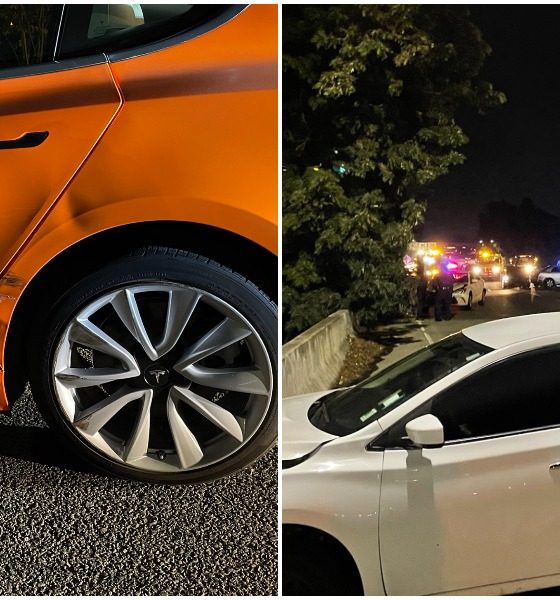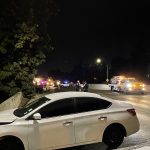

News
Tesla owner credits Autopilot for avoiding disaster in odd collision with distracted driver
A Tesla Model 3 owner is thanking his vehicle’s Autopilot system for saving his vehicle from fishtailing out of control after contact with a distracted driver.
During a nighttime drive on California Highway 880, a Model 3 owner who wished to be referred to as Rorlover, was minding his own business and using Tesla’s Autopilot functionality to travel. Suddenly, a Nissan sedan quickly approached the all-electric vehicle from the rear, shifted lanes, and appeared to attempt a “pit maneuver.” The contact sent the Nissan spinning into the left-hand retaining wall, while the Model 3 maintained control and safely slowed down and came to a halt on the shoulder of the road.
“I do credit the Tesla Autopilot for keeping the car heading straight after being hit,” Rorlover said to Teslarati. “I was really quite impressed.”
- Credit: u/Rorlover11 on Reddit
- Credit: u/Rorlover11 on Reddit
Rorlover initially posted the incident on a Subreddit, and although the incident appeared to be on purpose, Rorlover says the driver was actually distracted and accidentally made contact with his Tesla.
“The police report confirms there was nothing but a young and distracted driver. No road rage or attempted murder—hopefully, they’ve learned their lesson.”
The impact caused significant damage to the rear passenger door on the driver’s side of the Model 3, but it was by far the more fortunate vehicle in the event. The Nissan collided head-on with a jersey wall, sending debris all over the highway and ultimately lead to a six-vehicle pile-up that shut down the side of the highway the two cars were traveling on.
Rorlover walked away from the incident unharmed. The driver of the Nissan was taken to the hospital after a brief interview with Police, but the nature of their injuries is unknown.
The Model 3’s weight, which is supported by a large battery pack that gives the vehicle a low center of gravity, may have assisted in the car’s ability to maintain control. However, Rorlover’s description of the accident implies that Autopilot deserves more of the credit than the car’s weight distribution. Rorlover shared an exclusive video of the accident with Teslarati and stated that the impressive nature of Autopilot’s handling could be recognized from the Dashcam perspective of the vehicle.
“I didn’t share it initially as it’s not that exciting, unless you know it’s Autopilot doing the steering,” he said.
Tesla has made significant strides in its development of self-driving characteristics this year. In addition to releasing a more broad Autopilot functionality earlier this year that included driving on City Streets and Automatic Traffic Light Navigation, Tesla also rolled out its Full Self-Driving Beta in October. The release has revealed Tesla’s complex self-driving software, and CEO Elon Musk expects a Level 5 Autonomy version to be released next year.
The Model 3 already holds a Top Safety Pick+ recommendation from the Insurance Institute of Highway Safety (IIHS) and also achieved the lowest probability of injury of any vehicle ever tested by the National Highway Transportation Safety Administration (NHTSA). With its focus on semi-autonomous driving features, the inclusion of basic Autopilot with any Tesla car hints toward an even more robust safety system. After Autopilot prevented the Model 3 from fishtailing and colliding with a jersey wall, perhaps the system could contribute to even higher safety ratings in future tests.

News
Tesla China quietly posts Robotaxi-related job listing
Tesla China is currently seeking a Low Voltage Electrical Engineer to work on circuit board design for the company’s autonomous vehicles.

Tesla has posted a new job listing in Shanghai explicitly tied to its Robotaxi program, fueling speculation that the company is preparing to launch its dedicated autonomous ride-hailing service in China.
As noted in the listing, Tesla China is currently seeking a Low Voltage Electrical Engineer to work on circuit board design for the company’s autonomous vehicles.
Robotaxi-specific role
The listing, which was shared on social media platform X by industry watcher @tslaming, suggested that Tesla China is looking to fill the role urgently. The job listing itself specifically mentions that the person hired for the role will be working on the Low Voltage Hardware team, which would design the circuit boards that would serve as the nervous system of the Robotaxi.
Key tasks for the role, as indicated in the job listing, include collaboration with PCB layout, firmware, mechanical, program management, and validation teams, among other responsibilities. The role is based in Shanghai.
China Robotaxi launch
China represents a massive potential market for robotaxis, with its dense urban centers and supportive policies in select cities. Tesla has limited permission to roll out FSD in the country, though despite this, its vehicles have been hailed as among the best in the market when it comes to autonomous features. So far, at least, it appears that China supports Tesla’s FSD and Robotaxi rollout.
This was hinted at in November, when Tesla brought the Cybercab to the 8th China International Import Expo (CIIE) in Shanghai, marking the first time that the autonomous two-seater was brought to the Asia-Pacific region. The vehicle, despite not having a release date in China, received a significant amount of interest among the event’s attendees.
Elon Musk
Elon Musk and Tesla AI Director share insights after empty driver seat Robotaxi rides
The executives’ unoccupied tests hint at the rapid progress of Tesla’s unsupervised Robotaxi efforts.

Tesla CEO Elon Musk and AI Director Ashok Elluswamy celebrated Christmas Eve by sharing personal experiences with Robotaxi vehicles that had no safety monitor or occupant in the driver’s seat. Musk described the system’s “perfect driving” around Austin, while Elluswamy posted video from the back seat, calling it “an amazing experience.”
The executives’ unoccupied tests hint at the rapid progress of Tesla’s unsupervised Robotaxi efforts.
Elon and Ashok’s firsthand Robotaxi insights
Prior to Musk and the Tesla AI Director’s posts, sightings of unmanned Teslas navigating public roads were widely shared on social media. One such vehicle was spotted in Austin, Texas, which Elon Musk acknowleged by stating that “Testing is underway with no occupants in the car.”
Based on his Christmas Eve post, Musk seemed to have tested an unmanned Tesla himself. “A Tesla with no safety monitor in the car and me sitting in the passenger seat took me all around Austin on Sunday with perfect driving,” Musk wrote in his post.
Elluswamy responded with a 2-minute video showing himself in the rear of an unmanned Tesla. The video featured the vehicle’s empty front seats, as well as its smooth handling through real-world traffic. He captioned his video with the words, “It’s an amazing experience!”
Towards Unsupervised operations
During an xAI Hackathon earlier this month, Elon Musk mentioned that Tesla owed be removing Safety Monitors from its Robotaxis in Austin in just three weeks. “Unsupervised is pretty much solved at this point. So there will be Tesla Robotaxis operating in Austin with no one in them. Not even anyone in the passenger seat in about three weeks,” he said. Musk echoed similar estimates at the 2025 Annual Shareholder Meeting and the Q3 2025 earnings call.
Considering the insights that were posted Musk and Elluswamy, it does appear that Tesla is working hard towards operating its Robotaxis with no safety monitors. This is quite impressive considering that the service was launched just earlier this year.
Elon Musk
Starlink passes 9 million active customers just weeks after hitting 8 million
The milestone highlights the accelerating growth of Starlink, which has now been adding over 20,000 new users per day.

SpaceX’s Starlink satellite internet service has continued its rapid global expansion, surpassing 9 million active customers just weeks after crossing the 8 million mark.
The milestone highlights the accelerating growth of Starlink, which has now been adding over 20,000 new users per day.
9 million customers
In a post on X, SpaceX stated that Starlink now serves over 9 million active users across 155 countries, territories, and markets. The company reached 8 million customers in early November, meaning it added roughly 1 million subscribers in under seven weeks, or about 21,275 new users on average per day.
“Starlink is connecting more than 9M active customers with high-speed internet across 155 countries, territories, and many other markets,” Starlink wrote in a post on its official X account. SpaceX President Gwynne Shotwell also celebrated the milestone on X. “A huge thank you to all of our customers and congrats to the Starlink team for such an incredible product,” she wrote.
That growth rate reflects both rising demand for broadband in underserved regions and Starlink’s expanding satellite constellation, which now includes more than 9,000 low-Earth-orbit satellites designed to deliver high-speed, low-latency internet worldwide.
Starlink’s momentum
Starlink’s momentum has been building up. SpaceX reported 4.6 million Starlink customers in December 2024, followed by 7 million by August 2025, and 8 million customers in November. Independent data also suggests Starlink usage is rising sharply, with Cloudflare reporting that global web traffic from Starlink users more than doubled in 2025, as noted in an Insider report.
Starlink’s momentum is increasingly tied to SpaceX’s broader financial outlook. Elon Musk has said the satellite network is “by far” the company’s largest revenue driver, and reports suggest SpaceX may be positioning itself for an initial public offering as soon as next year, with valuations estimated as high as $1.5 trillion. Musk has also suggested in the past that Starlink could have its own IPO in the future.










